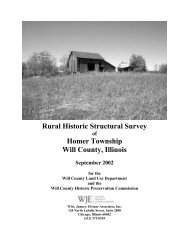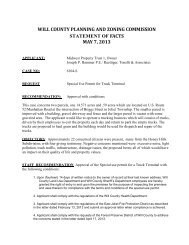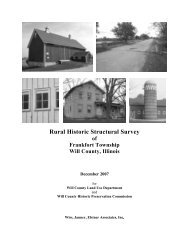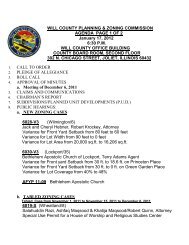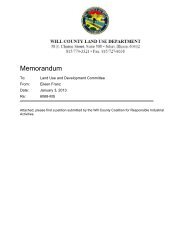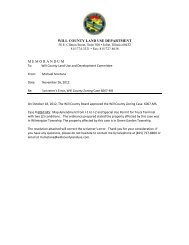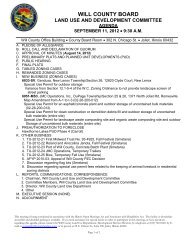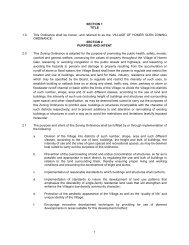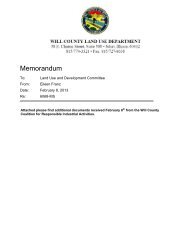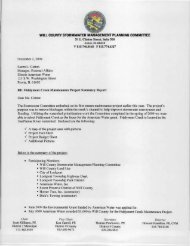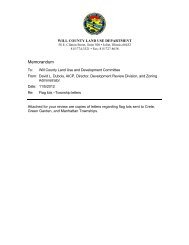Rural H Historic c Struct tural S Survey - Will County Land Use
Rural H Historic c Struct tural S Survey - Will County Land Use
Rural H Historic c Struct tural S Survey - Will County Land Use
You also want an ePaper? Increase the reach of your titles
YUMPU automatically turns print PDFs into web optimized ePapers that Google loves.
Wiss, Janney, Elstner Associates, Inc.<br />
The boom in agricul<strong>tural</strong> production that coincided with the opening of the Illinois and Michigan Canal in<br />
1848 was soon followed by the introduction of railroad service in the following decade. Plank roads were<br />
also a significant mode of transportation in the mid-nineteenth century.<br />
In the late 1840s, the United States still owned 14,060,308 acres of land in Illinois. Between 1848 and<br />
1857, much of this land passed into private hands. In addition to land that could be purchased from the<br />
government, alternate five mile Sections each side of the route planned for the Illinois and Michigan<br />
Canal in western <strong>Will</strong> <strong>County</strong> were offered for sale by the canal authority. Later, alternate six mile<br />
Sections on each side of the route granted to the Illinois Central Railroad (which passed through eastern<br />
<strong>Will</strong> <strong>County</strong>) were available for purchase from the railroad. 37<br />
In 1848, Illinois adopted township government as the basic level of local government, although in most<br />
locations functioning governments were not set up until 1850. By law, three services were to be provided<br />
by the townships: general assistance to the needy, property assessment for tax purposes, and maintenance<br />
of township roads and bridges. A unique feature of township government was the annual town meeting,<br />
held each April in all townships. This system continues to the present day. 38 Until the twentieth century,<br />
almost all public infrastructure (such as roads) was thus maintained by each township with local tax<br />
revenue.<br />
Agricul<strong>tural</strong> Development<br />
By the 1850s, Illinois was a major agricul<strong>tural</strong> state. Its corn production was 57.65 million bushels, which<br />
increased to 115.2 million in 1860, making it the leading corn producer in the nation. 39 Wheat was also a<br />
major crop—the state was fifth in wheat production in 1850 and first in 1860. Acreage in improved<br />
farmland increased two and one half times in the decade. Other principal farm crops were oats, rye, and<br />
barley. The average price for corn and wheat was $1.25 per bushel. In the early- to mid-1800s,<br />
agricul<strong>tural</strong> implements were primitive and included reapers, iron plowshares, and hay tenders. The first<br />
McCormick reaper in the <strong>County</strong> appeared in Wheatland Township in 1846. Some local inventions that<br />
could be attached to modify the McCormick included gearing produced by W. Holmes of Hickory Creek<br />
in <strong>Will</strong> <strong>County</strong>, produced at Adams’ Foundry, followed by a turf and stubble plow. 40<br />
The major crops in <strong>Will</strong> <strong>County</strong> historically have been corn and wheat, although wheat production<br />
declined in the later 1800s after infestations of the chinch bug and the army worm. (Wheat farming<br />
revived during World War I due to incentives from the U.S. government.) As early as 1850, corn was the<br />
during construction of the Interstate 355 tollway extension and associated overpasses. The marker was re-erected in<br />
July 2011 about 150 feet north of its original location.<br />
37<br />
The lands were sold to settlers and speculators. It is estimated that six million acres passed into the hands of<br />
speculators between 1849 and 1856. There were several types of speculators. Small farmers bought the land for<br />
pasturage, timber, or simply as an investment. Small businessmen also bought land as an investment, and in this<br />
group was included practically every prominent politician in Illinois except Abraham Lincoln. Professional<br />
speculators operated on a large scale, with corporations or individuals owning land in many states. Finally, East<br />
Coast capitalists invested in western lands—Samuel Allerton, a wealthy resident of New York, owned 2,000 acres in<br />
Frankfort, New Lenox, and Homer Townships in <strong>Will</strong> <strong>County</strong> and an additional 400 acres in Cook <strong>County</strong>. In time,<br />
settlers purchased the land from speculators. The Chicago <strong>Land</strong> Office was the last one opened and the last one<br />
closed, except for Springfield which took over all the unfinished work of all offices and remained open until 1877.<br />
(Shaw, <strong>Will</strong> <strong>County</strong> Agriculture, 1–2.)<br />
38<br />
Bryan Smith, “Township Government in Illinois: A Rich History, A Vibrant Future.”<br />
<br />
39<br />
“Corn” was the medieval term used in England for the grain known later as wheat. Settlers given “Indian corn”<br />
(maize) by the Native Americans began to sow it themselves, and corn (maize) became one of the leading grain<br />
crops in the United States by the 1800s. (United States Department of Agriculture, Yearbook of Agriculture (1936),<br />
496.)<br />
40<br />
Shaw, <strong>Will</strong> <strong>County</strong> Agriculture, 13.<br />
<strong>Will</strong> <strong>County</strong> <strong>Rural</strong> <strong>Historic</strong> <strong>Struct</strong>ural <strong>Survey</strong><br />
Page 16 Florence Township



